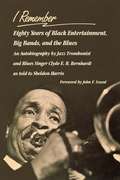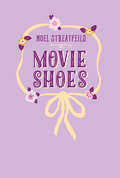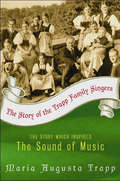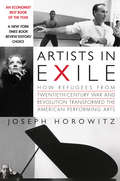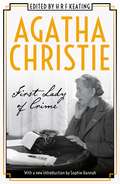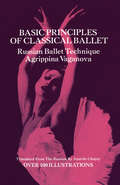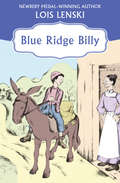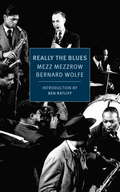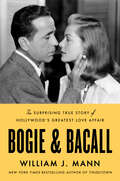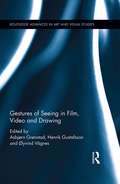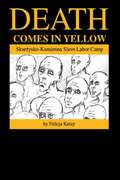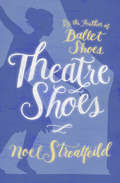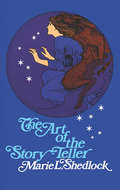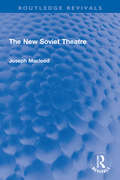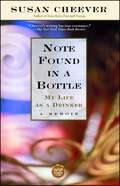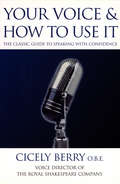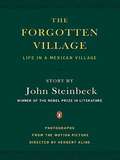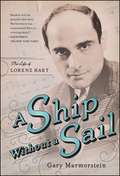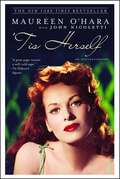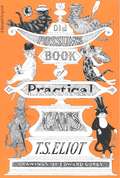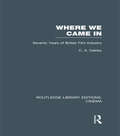- Table View
- List View
The Complete Canasta
by Ralph Michaels Charles H. Goren Josefina Artayeta De VielThis book teaches the reader how to play Canasta with 2, 4 or 6 people, and how to have a Canasta tournament.
I Remember
by Sheldon Harris Clyde E. Bernhardt John F. SzwedI Remember is a first-hand account of the world of black American music told by a man who has been part of that world for eighty years. Clyde E. B. Bernhardt worked with a number of bands, including King Oliver, Marion Hard, Cecil Scott, the Bascomb Brothers, and Joe Garland. He started his own band, the Blue Blazers, in 1946 and formed the Harlem Blues and Jazz Band in 1972.The book is a primary document that provides information about a part of the history of American music for which there is little documentation.
Movie Shoes (The Shoe Books)
by Noel StreatfeildFor the first time ever in the United States, the "Shoes" books are available as ebooks! Go behind the scenes of a movie in this beloved classic!Life is tough for the Winter family in London, with little money and Dad out of work. Luckily, Aunt Cora comes to the rescue with an invitation to live in California. From that moment on, talented Rachel and Tim dream of stardom in America. The family couldn't be more surprised when a movie producer picks plain, peevish Jane for the lead role of Mary in The Secret Garden. No one's ever noticed Jane before. Could this be the chance of a lifetime?Noel Streatfeild's "Shoes" books are some of the most popular of the thirty-eight books she wrote for children.
The Story of the Trapp Family Singers
by Maria Augusta TrappWith nearly 1,500 Broadway performances, six Tony Awards, more than three million albums sold, and five Academy Awards, The Sound of Music, based on the lives of Maria, the baron, and their singing children, is as familiar to most of us as our own family history. But much about the real-life woman and her family was left untold.Here, Baroness Maria Augusta Trapp tells in her own beautiful, simple words the extraordinary story of her romance with the baron, their escape from Nazi-occupied Austria, and their life in America.Now with photographs from the original edition.
Artists in Exile
by Joseph HorowitzDuring the first half of the twentieth century--decades of war and revolution in Europe--an "intellectual migration" relocated thousands of artists and thinkers to the United States, including some of Europe's supreme performing artists, filmmakers, playwrights, and choreographers. For them, America proved to be both a strange and opportune destination. A "foreign homeland" (Thomas Mann), it would frustrate and confuse, yet afford a clarity of understanding unencumbered by native habit and bias. However inadvertently, the condition of cultural exile would promote acute inquiries into the American experience. What impact did these famous newcomers have on American culture, and how did America affect them? George Balanchine, in collaboration with Stravinsky, famously created an Americanized version of Russian classical ballet. Kurt Weill, schooled in Berlin jazz, composed a Broadway opera. Rouben Mamoulian's revolutionary Broadway productions of Porgy and Bess and Oklahoma! drew upon Russian "total theater." An army of German filmmakers--among them F. W. Murnau, Fritz Lang, Ernst Lubitsch, and Billy Wilder--made Hollywood more edgy and cosmopolitan. Greta Garbo and Marlene Dietrich redefined film sexuality. Erich Korngold upholstered the sound of the movies. Rudolf Serkin inspirationally inculcated dour Germanic canons of musical interpretation. An obscure British organist reinvented himself as "Leopold Stokowski." However, most of these gifted émigrés to the New World found that the freedoms they enjoyed in America diluted rather than amplified their high creative ambitions.A central theme of Joseph Horowitz's study is that Russians uprooted from St. Petersburg became "Americans"--they adapted. Representatives of Germanic culture, by comparison, preached a German cultural bible--they colonized. "The polar extremes," he writes, "were Balanchine, who shed Petipa to invent a New World template for ballet, and the conductor George Szell, who treated his American players as New World Calibans to be taught Mozart and Beethoven." A symbiotic relationship to African American culture is another ongoing motif emerging from Horowitz's survey: the immigrants "bonded with blacks from a shared experience of marginality"; they proved immune to "the growing pains of a young high culture separating from parents and former slaves alike."
Lore of the Lumber Camps
by E. C. BeckA collection of songs/ballads and stories of the Michigan lumber camps of the 1800's.
Agatha Christie: First Lady of Crime
by Agatha ChristieIncludes a new introduction from Sophie Hannah, bestselling author of THE MONOGRAM MURDERS and HAVEN'T THEY GROWNAgatha Christie was not only the biggest selling writer of detective stories the world has ever known, she was also a mystery in herself, giving only the rarest interviews, declining absolutely to become any sort of public figure, and a mystery too in the manner in which she achieved her astonishing success.H R F Keating, a crime novelist and respected reviewer of crime fiction, brought together a dozen distinguished writers from both sides of the Atlantic to throw light on this double mystery. Some analyse the art itself; some explain the reasons for her success, not just the books, but also in film and theatre.The approaches are penetrating, affectionate, enthusiastic, analytical, funny - even critical. Together, they give an almost unique insight into the life and work of the First Lady of Crime.
Basic Principles of Classical Ballet
by Agrippina VaganovaAlthough the stars of Russian ballet Anna Pavlova and Tamara Karsavina possessed a national manner of dancing, there was no truly Russian school of dancing until the 1930s. The development of this school was largely due to Mme. Vaganova (1879-1951), not only a great dancer but also the teacher of Galina Ulanova and many others and an unsurpassed theoretician.The principles of Vaganova's system are presented in this well-known book. Mme. Vaganova's aim of creating a personal approach to the Russian dance was based on the critical assimilation of the experience of her contemporaries. Her ability to choose the best of what had been accomplished in the various ballet traditions (French, Italian, and Russian) and combine these into a unified teaching practice in itself amounted to a new school of dance. She firmly believed that the teaching process should be a planned exercise, ever changing with innovations in the dance. She sought from her pupils emotional expressiveness, strictness of form, a resolute, energetic manner of performance, and the understanding of the underlying coordination of movements.Her book discusses all basic principles of ballet, grouping movements by fundamental types. Chapters cover battements, rotary movements of the legs, the arms, poses of the classical dance, connecting and auxiliary movements, jumps, beats, point work, and turns as well as material for a sample lesson. Diagrams show clearly the exact foot, leg, arm, and body positions for the proper execution of many steps and movements. The result is a fundamental theory of dance that offers dancers, teachers, and ballet lovers information often difficult to locate in other books. 118 illustrations.
Blue Ridge Billy
by Lois LenskiA young boy dreams of music and sunshine in the Great Smoky Mountains As far as Billy is concerned, there's no sight more beautiful than the sun setting over the Blue Ridge Mountains. When the day is done, he sneaks away from his work to watch the sun go down. If his father knew, he would call Billy lazy, but Mama would understand. She knows life in the mountains is hard and that there's no point in living if a person can't take time to appreciate what he has. Billy dreams of the day when he can pick up his fiddle and sing the folk songs of his people. Until then, he will be content with the sun. This beautifully written novel tells a story of simple fun and irresistible pleasures in 1 of the most beautiful regions in the United States.
Really the Blues
by Ben Ratliff Mezz Mezzrow Bernard WolfeMezz Mezzrow was a Jewish boy from the slums of Chicago who learned to play the clarinet in reform school and pursued a life in music and a life of crime. He moved from Chicago to New Orleans to New York, working in brothels and bars, bootlegging, dealing drugs, getting hooked, doing time, producing records, and playing with the greats, among them Louis Armstrong, Bix Beiderbecke, and Fats Waller. Really the Blues, the jive-talking memoir that Mezzrow wrote at the insistence of, and with the help of, the novelist Bernard Wolfe, is the story of an unusual and unusually American life, and a picture of a man who moved freely across racial boundaries when few could or did, "the odyssey of an individualist. . . the saga of a guy who wanted to make friends in a jungle were everyone was too busy making money."
Bogie & Bacall: The Surprising True Story of Hollywood's Greatest Love Affair
by William J. MannFrom the noted Hollywood biographer and author of The Contender comes this celebration of the great American love story—the romance between Lauren Bacall and Humphrey Bogart—capturing its complexity, contradictions, and challenges as never before.In Bogie & Bacall, William Mann offers a deep and comprehensive look at Lauren Bacall, Humphrey Bogart, and the unlikely love they shared. Mann details their early years—Bogart’s effete upbringing in New York City; Bacall’s rise as a model and actress. He paints a vivid portrait of their courtship and twelve-year marriage: the fights, the reconciliations, the children, the affairs, Bogie’s illness and Bacall’s steadfastness until his death. He offers a sympathetic yet clear-eyed portrait of Bacall’s life after Bogie, exploring her relationships with Frank Sinatra and Jason Robards, who would become her second husband, and the identity crisis she faced.Surpassing previous biographies, Mann digs deep into the celebrities’ personal lives and considers their relationship from surprising angles. Bacall was just nineteen when she started dating the thrice-married forty-five-year-old Bogart. How might that age gap have influenced their relationship? In addition to what she gained, what might Bacall have lost by marrying a Hollywood superstar more than twice her age? How did Bogart, a man of average looks, become one of the greatest movie stars of all time? Throughout, Mann explains the unparalleled successes of their individual careers as well as the extraordinary love between them and the legend that has endured.Filled with entertaining details and thoughtful insights based on newly available records and correspondence, and illustrated with 30-40 photographs, Bogie & Bacall offers a fresh look at this famous couple, their remarkable relationship, and their legacy.
Gestures of Seeing in Film, Video and Drawing (Routledge Advances in Art and Visual Studies)
by Øyvind Vågnes Asbjørn Grønstad Henrik GustafssonThe first book of its kind, Gestures of Seeing in Film, Video and Drawing engages broadly with the often too neglected yet significant questions of gesture in visual culture. In our turbulent mediasphere where images – as lenses bearing on their own circumstances – are constantly mobilized to enact symbolic forms of warfare and where they get entangled in all kinds of cultural conflicts and controversies, a turn to the gestural life of images seems to promise a particularly pertinent avenue of intellectual inquiry. The complex gestures of the artwork remain an under-explored theoretical topos in contemporary visual culture studies. In visual art, the gestural appears to be that which intervenes between form and content, materiality and meaning. But as a conceptual force it also impinges upon the very process of seeing itself. As a critical and heuristic trope, the gestural galvanizes many of the most pertinent areas of inquiry in contemporary debates and scholarship in visual culture and related disciplines: ethics (images and their values and affects), aesthetics (from visual essentialism to transesthetics and synesthesia), ecology (iconoclastic gestures and spaces of conflict), and epistemology (questions of the archive, memory and documentation). Offering fresh perspectives on many of these areas, Gestures of Seeing in Film, Video and Drawing will be intensely awaited by readers from and across several disciplines, such as anthropology, linguistics, performance, theater, film and visual studies.
Death Comes in Yellow
by Felicja KarayDeath Comes in Yellow" presents the history of one slave labor camp in order to shed light on all aspects of the slave labor camps established in Poland under German occupation. Hasag-Skarzysko was one of hundreds of camps scattered throughout occupied Poland. They were distinguished by size, the nationality of the prisoners, their location, the date of their establishment, and the authority in charge. The large number of labor camps reflected the German policy of exploiting the work forces of the occupied countries. These camps were part of a Europe-wide system of forced labor.The first part of this volume reviews the external history of the camp. The second section, which studies the internal workings of the camp, is quite different in approach and includes an analysis of prisoner society and a moving description of the individual prisoner's struggle to survive.
Theatre Shoes
by Noel StreatfeildThis captivating companion to Ballet Shoes tells the story of 3 orphans who become students at a famous theatre school After their father disappeared in the war, Sorrell, Holly, and Mark Forbes were sent to live with their grandfather. When he dies, the three orphans are on the move again--this time to London, where their maternal grandmother is a well-known actress. The city is a strange, bustling place that frightens young Holly, but the siblings' new home at 14 Ponsonby Square has a garden that instantly enchants them. Their grandmother enrols them at the Children's Academy of Dancing and Stage Training, where they'll carry on the tradition of their famous theatre family, which includes cousins they never knew they had. Stuck-up Miranda thinks she can act better than Sorrel; homesick Mark discovers he can sing; and Holly is a natural dancer. Will Sorrel, Holly, and Mark live up to their family legacy?
The Art of the Story-Teller
by Marie L. Shedlock"It is a delight to see a new edition of this long out-of-print book, the best on the subject of stpry-telling." -- The Junior Bookshelf. Everything you need to know to tell stories successfully to children: choosing material, using gestures, capturing straying attentions, more. 18 ready-for-telling stories written especially for youngsters. Annotated bibliography of 135 stories.
The New Soviet Theatre (Routledge Revivals)
by Joseph MacleodFirst Published in 1943, The New Soviet Theatre presents Joseph Macleod’s take on the development and rapid changes in the Soviet Theatre since late 1930s. Through scattered articles and reports, books and bulletins, and his own visits to the USSR, Macleod showcases what we know as ‘Socialist Realism’. He brings themes like the shortcomings of the old theatre; the audience beyond the Caucasus; new socialist audiences; Alexey Popov of the Central Theatre of the Red Army; new writers and new plays; and popularity of Shakespeare both in the central theatres and in remoter and unexpected places. Written graphically but founded on scholarship this book will be an essential read for scholars and researchers of history of theatre, European theatre, theatre and performance studies.
Note Found in a Bottle: My Life As A Drinker
by Susan CheeverBorn into a world ruled and defined by the cocktail hour, in which the solution to any problem could be found in a dry martini or another glass of wine, Susan Cheever led a life both charmed and damned. She and her father, the celebrated writer John Cheever, were deeply affected and troubled by alcohol. Addressing for the first time the profound effects that alcohol had on her life, in shaping of her relationships with men and in influencing her as a writer, Susan Cheever delivers an elegant memoir of clear-eyed candor and unsettling immediacy. She tells of her childhood obsession with the niceties of cocktails and all that they implied -- sociability, sophistication, status; of college days spent drinking beer and cheap wine; of her three failed marriages, in which alcohol was the inescapable component, of a way of life that brought her perilously close to the edge. At once devastating and inspiring, Note Found in a Bottle offers a startlingly intimate portrait of the alcoholic's life -- and of the corageous journey to recovery.
Your Voice and How to Use it
by Cicely BerryAnxiety about how we speak prevents many of us from expressing ourselves well. In her classic handbook, Cicely Berry, Voice Director of the Royal Shakespeare Company and world-famous voice teacher, tackles the reasons for this anxiety and explains her practical exercises for relaxation and breathing, clarity of diction and vocal flexibility - everything that you need to achieve good speech.
Steppin and Family
by Hope NewellTo Steppin, brown, eager and limber, tap-dancing was the only art in the world, but Harlem boys don't have much money for dancing lessons; and fame seemed very far away as he sat forlornly under the Wishing Tree. Little could Steppin Stebbins imagine the twists and turns in his home life and budding career in the year to follow. From his little corner of Harlem, to the wide open country of upstate New York, and even eventually to the lights of Broadway, Steppin Stebbin knows only one thing; his dream is to dance with the world's most famous tap dancer, Bob Williams. This is a prequel to the Mary Ellis nursing series.
The Forgotten Village: Life in a Mexican Village
by John Steinbeck Alexander Hackensmid Rosa Harvan KlineThe novelist who wrote The Grapes of Wrath and the director who produced Crisis and Lights Out in Europe combined their superb talents to tell the story of the coming of modern medicine to the natives of Mexico. There have been several notable examples of this pen-camera method of narration, but The Forgotten Village is unique among them in that the text was written before a single picture was shot. The book and the movie from which it was made have, thus, a continuity and a dramatic growth not to be found in the so-called "documentary" films. The camera crew that, headed by Kline and with Steinbeck's script at hand, recorded this narrative of birth and death, of witch doctors and vaccines, of the old Mexico and the new, spent nine months off the trails of Mexico. They traveled thousands of miles to find just the village they needed; they borrowed children from the government school, took men from the fields, their wives from the markets, and old medicine woman from her hut by the side of the trail. The motion picture they made (for release in 1941) is 8000 feet long. From this wealth of pictures 136 photographs were selected for their intrinsic beauty and for the graceful harmony with which they accompany Steinbeck's text. This new script-photograph technique of narration conveys its ideas with unexcelled brilliance and immediacy. In the hands of such master story-tellers as Steinbeck and Kline, it makes the reader catch his breath for the beauty and the truth of the tale.
A Ship Without A Sail: The Life of Lorenz Hart
by Gary MarmorsteinAn unforgettable portrait of an exuberant yet troubled artist who so enriched the American songbook "Blue Moon, " "Where or When, " "The Lady Is a Tramp," "My Funny Valentine," "Isn't It Romantic?," "My Romance," "There's a Small Hotel," "Falling in Love with Love," "Bewitched, Bothered and Bewildered"--lyricist Lorenz Hart, together with composer Richard Rodgers, wrote some of the most memorable songs ever created. More than half a century after their collaboration ended, Rodgers & Hart songs are indispensable to the repertoire of nightclub singers everywhere. A Ship Without a Sail is the story of the complicated man who was Lorenz Hart. His lyrics spin with brilliance and sophistication, yet at their core is an unmistakable wistfulness. The sweetness of "My Romance" and "Isn't It Romantic?" is unsurpassed in American song, but Hart's lyrics could also be cynical, funny, ironic. He brought a unique wit and elegance to popular music. Larry Hart and Richard Rodgers wrote approximately thirty Broadway musicals and dozens of songs for Hollywood films. At least four of their musicals--On Your Toes, Babes in Arms, The Boys from Syracuse, and Pal Joey-- have become classics. But despite their prodigious collaboration, Rodgers and Hart were an odd couple. Rodgers was precise, punctual, heterosexual, handsome, and eager to be accepted by Society. Hart was barely five feet tall, alcoholic, homosexual, and more comfortable in a bar or restaurant than anywhere else. Terrified of solitude, he invariably threw the party and picked up the check. His lyrics are all the more remarkable considering that he never sustained a romantic relationship, living his entire life with his mother, who died only months before he died at age forty-eight. Gary Marmorstein's revelatory biography includes many of the lyrics that define Hart's legacy--those clever, touching stanzas that still move us or make us laugh.
'Tis Herself: A Memoir
by Maureen O'Hara John NicolettiA first-ever revealing and candid look at the life and career of one of Hollywood&’s brightest and most beloved stars, Maureen O&’Hara.In an acting career of more than seventy years, Hollywood legend Maureen O’Hara came to be known as “the queen of Technicolor” for her fiery red hair and piercing green eyes. She had a reputation as a fiercely independent thinker and champion of causes, particularly those of her beloved homeland, Ireland. In ‘Tis Herself, O’Hara recounts her extraordinary life and proves to be just as strong, sharp, and captivating as any character she played on-screen. O’Hara was brought to Hollywood as a teenager in 1939 by the great Charles Laughton, to whom she was under contract, to costar with him in the classic film The Hunchback of Notre Dame. She has appeared in many other classics, including How Green Was My Valley, Rio Grande, The Quiet Man, and Miracle on 34th Street. She recalls intimate memories of working with the actors and directors of Hollywood’s Golden Age, including Laughton, Alfred Hitchcock, Tyrone Power, James Stewart, Henry Fonda, and John Candy. With characteristic frankness, she describes her tense relationship with the mercurial director John Ford, with whom she made five films, and her close lifelong friendship with her frequent costar John Wayne. Successful in her career, O’Hara was less lucky in love until she met aviation pioneer Brigadier General Charles F. Blair, the great love of her life, who died in a mysterious plane crash ten years after their marriage. Candid and revealing, ‘Tis Herself is an autobiography as witty and spirited as its author.
The Kingdom Of Swing
by Irving Kolodin Benny Goodmanthe book deals with the life of Benny Goodman up to the year 1939. Since he lived 37 years after this publishing, it is only partly the story of his life.
Old Possum's Book of Practical Cats
by T. S. EliotCats! Some are sane, some are mad and some are good and some are bad. Meet magical Mr Mistoffelees, sleepy Old Deuteronomy and curious Rum Tum Tugger. But you'll be lucky to meet Macavity because Macavity's not there!In 1925 T. S. Eliot became co-director of Faber and Faber, who remain his publishers to this day. Throughout the 1930s he composed the now famous poems about Macavity, Old Deuteronomy, Mr Mistoffelees and many other cats, under the name of 'Old Possum'. In 1981 Eliot's poems were set to music by Andrew Lloyd Webber as Cats which went on to become the longest-running Broadway musical in history. This new edition, published on the 70th anniversary of the book and on the 80th anniversary of Faber and Faber, contains original colour illustrations by the award-winning illustrator of The Gruffalo, Axel Scheffler.
Where we Came In: Seventy Years of the British Film Industry (Routledge Library Editions: Cinema)
by Charles Allen OakleyOriginally published in 1964, this book tells the history of the British cinematograph industry for the first time. It describes moments of splendid triumph and others of shattering failure. The mood switches from reckless optimism to demoralising pessimism, from years in which British films won the highest international awards to those when they were dismissed with scorn. It recalls a score of productions still ranked among the world's best, and the stars whose reputation was established in them. Attention is focused on the directors, those who kept to the fore during two and three decades and those with only one major success to their name. Behind them the men are identified who strove, often to their considerable financial loss, to gain a worthy place for British films in the world’s markets.

